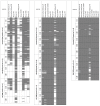Limited stability of microcystins in oligopeptide compositions of Microcystis aeruginosa (Cyanobacteria): implications in the definition of chemotypes
- PMID: 23744054
- PMCID: PMC3717771
- DOI: 10.3390/toxins5061089
Limited stability of microcystins in oligopeptide compositions of Microcystis aeruginosa (Cyanobacteria): implications in the definition of chemotypes
Abstract
The occurrence of diverse oligopeptides in cyanobacteria, including the cyanotoxins microcystins, has been recently used to classify individual clones into sub-specific oligopeptide chemotypes, whose composition and dynamics modulate microcystin concentrations in cyanobacterial blooms. Cyanobacterial chemotyping allows the study of the ecology of chemotypical subpopulations, which have been shown to possess dissimilar ecological traits. However, the stability of chemotypes under changing abiotic conditions is usually assumed and has not been assessed in detail. We monitored oligopeptide patterns of three strains of Microcystis aeruginosa under different nutrient and light conditions. MALDI-TOF MS revealed alterations in the microcystins signatures under N and P poor conditions and high light intensities (150 and 400 μmol photons m-2s-1). Variations in the general oligopeptide composition were caused by a gradual disappearance of microcystins with low relative intensity signals from the fingerprint. The extent of such variations seems to be closely related to physiological stress caused by treatments. Under identical clonal compositions, alterations in the oligopeptide fingerprint may be misinterpreted as apparent shifts in chemotype succession. We discuss the nature of such variations, as well as the consequent implications in the use of cyanobacterial chemotyping in studies at the subpopulation level and propose new guidance for the definition of chemotypes as a consistent subpopulation marker.
Figures


Similar articles
-
Spatial-temporal survey of Microcystis oligopeptide chemotypes in reservoirs with dissimilar waterbody features and their relation to genetic variation.Harmful Algae. 2019 Jan;81:77-85. doi: 10.1016/j.hal.2018.11.009. Epub 2018 Dec 11. Harmful Algae. 2019. PMID: 30638501
-
Evaluating the influence of light intensity in mcyA gene expression and microcystin production in toxic strains of Planktothrix agardhii and Microcystis aeruginosa.J Microbiol Methods. 2016 Apr;123:4-12. doi: 10.1016/j.mimet.2016.02.002. Epub 2016 Feb 3. J Microbiol Methods. 2016. PMID: 26851673
-
Diversity and distribution of Microcystis (Cyanobacteria) oligopeptide chemotypes from natural communities studied by single-colony mass spectrometry.Microbiology (Reading). 2004 Jun;150(Pt 6):1785-1796. doi: 10.1099/mic.0.26947-0. Microbiology (Reading). 2004. PMID: 15184565
-
A review on factors affecting microcystins production by algae in aquatic environments.World J Microbiol Biotechnol. 2016 Mar;32(3):51. doi: 10.1007/s11274-015-2003-2. Epub 2016 Feb 13. World J Microbiol Biotechnol. 2016. PMID: 26874538 Review.
-
The dual role of nitrogen supply in controlling the growth and toxicity of cyanobacterial blooms.Harmful Algae. 2016 Apr;54:87-97. doi: 10.1016/j.hal.2016.01.010. Harmful Algae. 2016. PMID: 28073483 Review.
Cited by
-
Effects of secondary metabolites produced by different cyanobacterial populations on the freshwater zooplankters Brachionus calyciflorus and Daphnia pulex.Environ Sci Pollut Res Int. 2019 Apr;26(12):11793-11804. doi: 10.1007/s11356-019-04543-1. Epub 2019 Feb 27. Environ Sci Pollut Res Int. 2019. PMID: 30815809 Free PMC article.
-
Non-ribosomal peptides produced by Planktothrix agardhii from Siemianówka Dam Reservoir SDR (northeast Poland).Arch Microbiol. 2014 Oct;196(10):697-707. doi: 10.1007/s00203-014-1008-9. Epub 2014 Jun 28. Arch Microbiol. 2014. PMID: 24972671 Free PMC article.
-
Microcystins contamination of surface water supply sources in Zaria-Nigeria.Environ Monit Assess. 2015 Oct;187(10):606. doi: 10.1007/s10661-015-4829-3. Epub 2015 Sep 2. Environ Monit Assess. 2015. PMID: 26329267
-
A Novel and Native Microcystin-Degrading Bacterium of Sphingopyxis sp. Isolated from Lake Taihu.Int J Environ Res Public Health. 2017 Oct 6;14(10):1187. doi: 10.3390/ijerph14101187. Int J Environ Res Public Health. 2017. PMID: 28984840 Free PMC article.
-
Meteorological and Nutrient Conditions Influence Microcystin Congeners in Freshwaters.Toxins (Basel). 2019 Oct 26;11(11):620. doi: 10.3390/toxins11110620. Toxins (Basel). 2019. PMID: 31717743 Free PMC article.
References
-
- Codd G.A., Morrison L.F., Metcalf J.S. Cyanobacterial toxins: Risk management for health protection. Toxicol. Appl. Pharmacol. 2005;203:264–272. - PubMed
-
- Komarek J., Kling H. Variation in 6 planktonic cyanophyte genera in lake Victoria (East-Africa) Arch. Hydrobiol. 1991;88:21–45.
-
- Sivonen K., Jones G. Cyanobacterial Toxins. In: Chorus I., Bartram J., editors. Toxic Cyanobacteria in Water. A Guide to Their Public Health Consequences, Monitoring and Management. E & FN Spoon; London, UK: 1999. pp. 41–111.
Publication types
MeSH terms
Substances
LinkOut - more resources
Full Text Sources
Other Literature Sources

